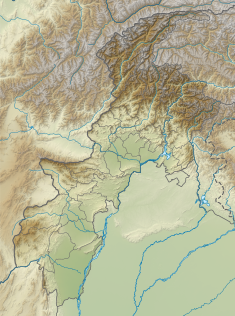| Tarbela Dam | |
|---|---|
 Aerial view of the dam and Tarbela Lake reservoir | |
| Official name | Tarbela Dam |
| Location | Haripur District, Khyber Pakhtunkhwa, Pakistan |
| Coordinates | 34°05′23″N 72°41′54″E / 34.0897222222°N 72.6983333333°E |
| Purpose | Water Storage, Power Generation |
| Status | Operational |
| Construction began | 1968 |
| Opening date | 1976 |
| Construction cost | 2.85 Billion USD |
| Owner(s) | Government of Pakistan |
| Operator(s) | Water and Power Development Authority |
| Dam and spillways | |
| Type of dam | Earth and rock filled dam |
| Impounds | Indus River |
| Height (foundation) | 470 feet (143 m) |
| Height (thalweg) | 485 feet (148 m) |
| Length | 9,000 feet (2,743 m) |
| Dam volume | 139,000,000 cu yd (106,000,000 m3) |
| Spillways | 16 ( 7 Service + 9 Auxiliary) |
| Spillway capacity | Service 650,000 cusecs + Auxiliary 850,000 cusecs |
| Reservoir | |
| Creates | Tarbela Reservoir |
| Total capacity | 11,620,000 acre⋅ft (14.33 km3) (1974) |
| Active capacity | 9,679,000 acre⋅ft (11.939 km3) (1974) |
| Inactive capacity | 1,941,000 acre⋅ft (2.394 km3) (1974) |
| Catchment area | 65,500 sq mi (170,000 km2) |
| Surface area | 100 sq mi (260 km2) |
| Maximum water depth | 450 ft (140 m) |
| Normal elevation | 1,464 ft (446 m) |
| Power Station | |
| Commission date | 1977–1982 |
| Turbines | 10 × 175 MW 4 × 432 MW 3 × 470 MW |
| Installed capacity | 4,888 MW |
| Annual generation | 17,395 GWh (2020) |
Tarbela Dam (Pashto: د توربېلې بند, Hindko: تربیلا بند) is an earth-filled dam along the Indus River in Pakistan's Khyber Pakhtunkhwa province. It is mainly located in Haripur Tehsil.[1] It is about 20 km (10 mi) from the city of Swabi KPK, 105 km (65 mi) northwest of Islamabad, and 125 km (80 mi) east of Peshawar. It is the largest earth-filled dam in the world.[2][3][4] The dam is 143 metres (470 ft) high above the riverbed and its reservoir, Tarbela Lake, has a surface area of approximately 250 square kilometres (97 sq mi).[citation needed]
The Tarbela Dam is located on the Indus River near the village of Tarbela in Bara, approximately 30 kilometers from the town of Attock. Positioned where the Indus River emerges from the foothills of the Himalayas and enters the Potwar Plateau, the dam features a reservoir for water storage. The average annual flow available is 101 billion cubic meters (3221 m3/sec).[5] It stands 143 meters tall and covers an area of 243 square kilometers. It has a storage capacity of 11.9 billion cubic meters of water and has nine gates to control the outflow of water. The dam was completed in 1976 and was designed to utilize water from the Indus River for irrigation, flood control, and the generation of hydroelectric power[6] by storing flows during the monsoon period while subsequently releasing stored water during the low flow period in winter. The installed capacity of the 4,888 MW Tarbela hydroelectric power stations will increase to 6,418 MW after completion of the planned fifth extension financed by Asian Infrastructure Investment Bank and the World Bank. Then, it will be the 12th largest hydroelectric dam in the world, for electricity production capacity. [7]
- ^ Tarbela Dam. WAPDA.
- ^ Asianics Agro-Dev. International (Pvt) Ltd. (2000). Tarbela Dam and related aspects of the Indus River Basin, Pakistan (PDF) (Report). Cape Town: World Commission on Dams. Archived from the original (PDF) on 2010-06-13. Retrieved 2010-10-28.
- ^ Earth Sciences Web Team. "Tarbela Dam, Pakistan". Earth Observatory. National Aeronautics and Space Administration. Archived from the original on 2010-07-15. Retrieved 2010-10-28.
- ^ "Tarbela Dam". PakistanPaedia. 2006-08-07. Retrieved 2012-01-26.
- ^ "Detection of Sediment Trends Using Wavelet Transforms in the Upper Indus River". Retrieved 13 May 2024.
- ^ Rodney White (1 January 2001). Evacuation of Sediments from Reservoirs. Thomas Telford Publishing. pp. 163–169. ISBN 978-0727729538. Retrieved 4 August 2013.
- ^ "Tarbela 5th extension project to generate electricity by 2025". 20 May 2023. Retrieved 31 May 2023.

